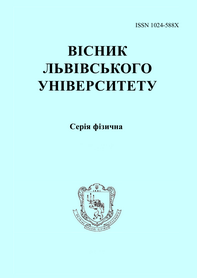DOI: https://doi.org/10.30970/vph.60.2023.44
CHECKING THE RELIABILITY OF CALIBRATION EXPRESSIONS FOR DETERMINING THE OXYGEN ABUNDANCES IN REGIONS OF IONIZED HYDROGEN USING MODELLING METHOD
B. Melekh, M. Shevchenko, D. Shelestiuk

| Visnyk of the Lviv University. Series Physics
60 (2023) ñ. 44-60
DOI: https://doi.org/10.30970/vph.60.2023.44 CHECKING THE RELIABILITY OF CALIBRATION EXPRESSIONS FOR DETERMINING THE OXYGEN ABUNDANCES IN REGIONS OF IONIZED HYDROGEN USING MODELLING METHODB. Melekh, M. Shevchenko, D. Shelestiuk |  |
Calibration relationships for determining the oxygen abundance in regions of ionized hydrogen are frequently used in the analysis of observed nebular emission line spectra. These relationships, based on strong emission lines present in all observed spectra, play a crucial role in testing chemodynamical theories of galaxies and we have to be sure that they are reliable indicators. We performed a verification of 18 popular calibration methods for determining oxygen abundance in regions ofionized hydrogen surrounding the star-forming regions. To achieve this, we selected modelling spectra generated through multicomponent photoionization modelling of these objects, using data obtained from chemodynamical simulations (ChDSs) of their evolution. To reproduce important emission line ratios within the observed range, we introduced a thin dense shell (TDS) in the modelling volume situated between the internal superwind regions (consisting of rarefied but highly heated shocked gas) and the outer photoionized gas of the nebula. The thickness of the TDS at its maximum density does not exceed 4 pc, corresponding to the resolution of the employed ChDSs. By calculating the spectra within a small central synthetic aperture (with a size smaller than the angular size of the region of ionized hydrogen), we were able to determine the oxygen abundances. These abundances were compared with corresponding values obtained by averaging over the modelling volume observed within the synthetic aperture, weighted by mass. Two calibrations based on N2 indicators showed excellent testing result, three ones demonstrated good results, four methods showed acceptable results, and nine calibrations yielded unacceptable result.